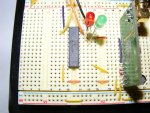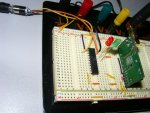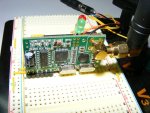At the risk of the scorn of the forum I'm having issues with wireless and need a little assistance.
What I want to do:
Send 8 byte variable on a wireless link using the HopeRF modules.
These variables are attached to sensors and I have that end all sorted.
On the reciever end I would like to have the variables as they were .
I have been trying using the HopeRF modules(not the TTL units) and 20M chips on breadboard and keeping the enable high constantly.
The config has been grounded
I have built stans purring unit and it works 7 km LOS and across my desk very nicely thank you.
I tried to debug both the transmitter and the reciever and could not debug the reciever.
I went back to the 433mhz transmitter and reciever units we used pre HopeRF and I have been pushing a variable across the great divide no worries.
But when I went to use more than on variable the reciever seemed to pick up my pre amble rather than my variables.
debug picks up b0 (info) as 6
but it picks up b1 - b7 as 85 ( which is U) this is my pre amble
If it was mechanical I could watch it and work it out, if it was a circuit issue I could work it out but not today.
I have looked at a lot of forum entrys and tried the african radio manufacturers method ( use some one elses and pull out parts, if it still works don't bother using it in the new design) I have even read the manual but I think I need a fresh approach again.
This is not for a school project I won't get extra credits and it is not due next week I just want to get this right to build my project.
HELP,
What I want to do:
Send 8 byte variable on a wireless link using the HopeRF modules.
These variables are attached to sensors and I have that end all sorted.
On the reciever end I would like to have the variables as they were .
I have been trying using the HopeRF modules(not the TTL units) and 20M chips on breadboard and keeping the enable high constantly.
The config has been grounded
I have built stans purring unit and it works 7 km LOS and across my desk very nicely thank you.
I tried to debug both the transmitter and the reciever and could not debug the reciever.
I went back to the 433mhz transmitter and reciever units we used pre HopeRF and I have been pushing a variable across the great divide no worries.
But when I went to use more than on variable the reciever seemed to pick up my pre amble rather than my variables.
Code:
`433mhz transmitter 08M
main:
b0 = 6
b1 = 12
b2 = 18
b3 = 24
b4 = 30
b5 = 36
b6 = 42
b7 = 48
serout 2,N1200,("UUUUUUUTW",b0,b1,b2,b3,b4,b5,b6,b7)
high 1
pause 50
low 1
pause 100
goto main
`433mhz reciever 08M
symbol info = b0
main:
info =0
b1 = 0
b2 = 0
b3 = 0
b4 = 0
b5 = 0
b6 = 0
b7 = 0
serin 3, N1200, ("TW"),info,b1,b2,b3,b4,b5,b6,b7
debug info
pause 5
if info = 6 then correct
goto wrong
correct:
high 2
pause 20
low 2
pause 20
goto main
wrong:
high 4
pause 20
low 4
pause 20
goto mainbut it picks up b1 - b7 as 85 ( which is U) this is my pre amble
If it was mechanical I could watch it and work it out, if it was a circuit issue I could work it out but not today.
I have looked at a lot of forum entrys and tried the african radio manufacturers method ( use some one elses and pull out parts, if it still works don't bother using it in the new design) I have even read the manual but I think I need a fresh approach again.
This is not for a school project I won't get extra credits and it is not due next week I just want to get this right to build my project.
HELP,



